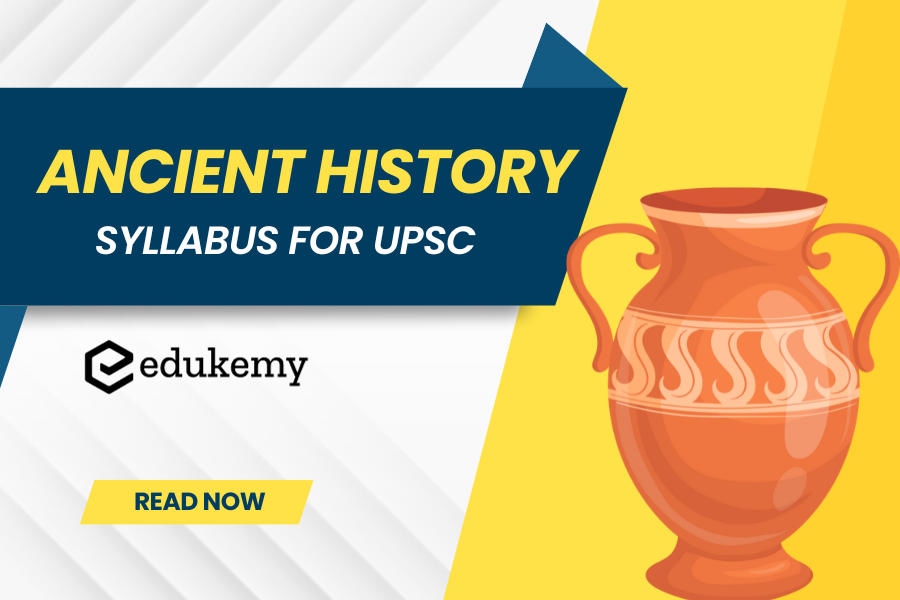
When gearing up for the UPSC IAS, it’s essential to have a comprehensive understanding of the Ancient History Syllabus, especially when delving into the realm of ancient history. The questions posed in the UPSC IAS prelims exam typically range from moderate to tough in terms of difficulty.
A significant portion of these questions focuses on Ancient Indian History, a rich tapestry that unfolds the narratives of the Indus Valley Civilization, the Vedic Period, the Mauryan and Gupta periods, various kingdoms, the intriguing tales of the Delhi Sultanate, and the grandeur of the Mughal Empire.
Both UPSC IAS Prelims and Mains exams require a thorough and comprehensive understanding of Ancient Indian History, which forms the bedrock of the nation’s cultural and historical heritage.
Here, we present the complete History syllabus for UPSC IAS to help you prepare more effectively. The History portion of UPSC IAS Prelims Exam General Studies Paper I Syllabus encompasses questions not only from Ancient Indian History but also from Medieval and Modern Indian History, as well as Indian art and culture. Embracing the roots of civilization and exploring the bygone eras will undoubtedly enhance your grasp of historical nuances and contribute to a more holistic preparation for the esteemed examination.
Contents
- 1 Ancient History Syllabus for UPSC IAS Exam
- 2 FAQs on Ancient History Syllabus
- 2.1 Q1: What is the scope of the Ancient History syllabus for UPSC?
- 2.2 Q2: How important is the understanding of archaeological sources in the Ancient History syllabus?
- 2.3 Q3: What are the major themes covered under Ancient Indian History?
- 2.4 Q4: How should candidates approach the study of ancient cultures and religions in the UPSC Ancient History syllabus?
- 2.5 Q5: Are there any specific regions or civilizations outside of India covered in the Ancient History syllabus?
- 3 In case you still have your doubts, contact us on 8792740517.
Ancient History Syllabus for UPSC IAS Exam
- Prehistoric cultures in India
- Indus Civilization: Origins, different phases, society, economy, culture, and contacts with other cultures, as well as factors leading to its decline.
- Geographical distribution and characteristics of pastoral and farming societies.
- Vedic society: Vedic texts, transition from Rigvedic to later Vedic phases, religious beliefs, Upanishad thought, political and social organization, evolution of the Varna system, and monarchy.
- Formation of the State and urbanization: From the Mahajanapadas to the Nandas.
- Buddhism and Jainism: Factors contributing to the spread of Buddhism.
- The Mauryan Empire: Chandragupta, Megasthenes, Asoka, his inscriptions, dhamma, culture, administration, and art.
- Society in Post-Mauryan India (BC 200 – AD 300): Evolution of Jatis.
- The Satavahanas and the formation of the state in the Peninsula.
- Sangam texts and society.
- Indo-Greeks, Sakas, Parthians, Kushans, Kanishka: Contacts with the outer world.
- Different Religions: Bhagavatism, Saivism, Mahayana Buddhism, Hinayana, Jainism, and Culture and art.
- The Guptas and their descendants: Literature, Science, Arts, Economy, and society, modification in the political organization of the empire.

FAQs on Ancient History Syllabus
Q1: What is the scope of the Ancient History syllabus for UPSC?
A: The Ancient History syllabus for UPSC covers the period from the Stone Age to the end of the Gupta Empire (circa 3000 BCE to 600 CE). It includes the study of early civilizations, Vedic period, Mauryan and Gupta dynasties, ancient cultures, religions, and significant events that shaped the Indian subcontinent.
Q2: How important is the understanding of archaeological sources in the Ancient History syllabus?
A: Archaeological sources play a crucial role in Ancient History for UPSC. Candidates are required to analyze artifacts, inscriptions, and archaeological sites to reconstruct historical narratives. Questions often assess the ability to interpret these sources and draw meaningful conclusions about ancient societies.
Q3: What are the major themes covered under Ancient Indian History?
A: The Ancient Indian History syllabus includes themes such as political developments, social structures, economic activities, religious and cultural practices, and interactions with neighboring civilizations. Candidates should be well-versed in the historical context and evolution of these themes.
Q4: How should candidates approach the study of ancient cultures and religions in the UPSC Ancient History syllabus?
A: Candidates should study ancient cultures and religions with a focus on their socio-economic and political impact. Understanding the philosophical underpinnings, cultural expressions, and their influence on governance is essential. Examples include the evolution of Hinduism, Buddhism, Jainism, and the cultural aspects of the Mauryan and Gupta periods.
Q5: Are there any specific regions or civilizations outside of India covered in the Ancient History syllabus?
A: While the primary focus is on the Indian subcontinent, the UPSC Ancient History syllabus also encompasses the study of ancient civilizations outside India that had interactions with the subcontinent. This includes the Hellenistic world, the Persian Empire, and the trade routes connecting India with other regions. Candidates should be familiar with the cultural exchanges and historical linkages that shaped ancient India’s external relations.
In case you still have your doubts, contact us on 8792740517.
For UPSC Prelims Resources, Click here
For Daily Updates and Study Material:
Join our Telegram Channel – Edukemy for IAS
- Learn through Videos – here
- Be Exam Ready by Practicing Daily MCQs – here
- Daily Newsletter – Get all your Current Affairs Covered – here
- Mains Answer Writing Practice – here

